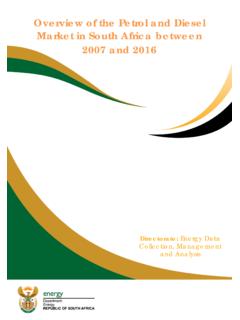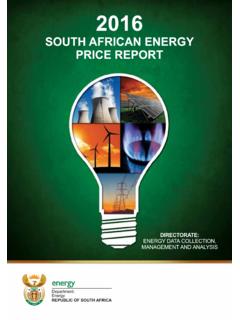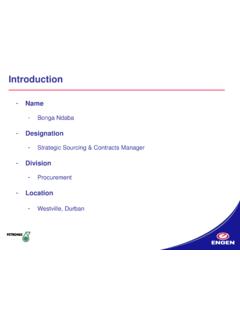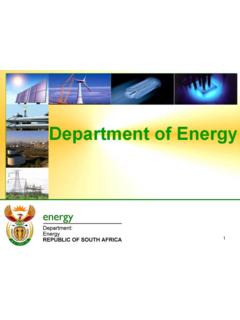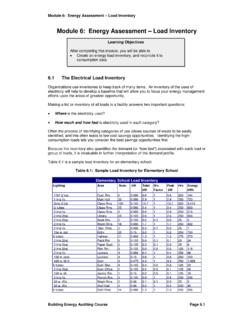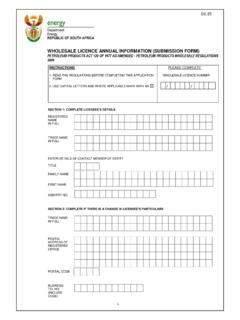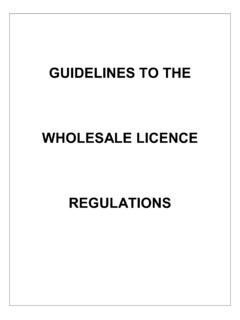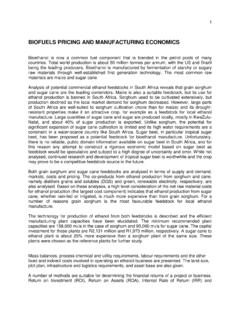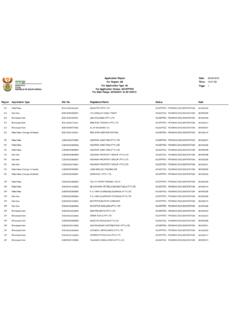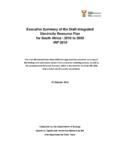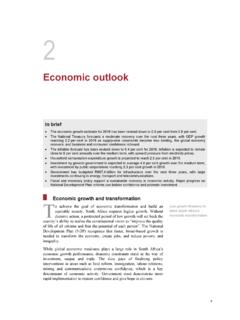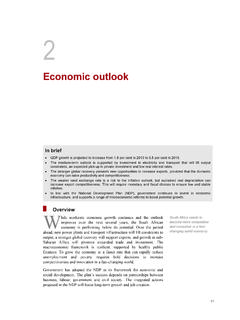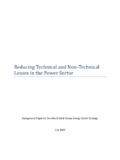Transcription of CSIR Report Cover - Department Of Energy
1 1 CSIR 2015 All rights to the intellectual property and/or contents of this document remain vested in the CSIR. This document is issued for the sole purpose for which it is supplied. No part of this publication may be reproduced, stored in a retrieval system or transmitted, in any form or by means electronic, mechanical, photocopying, recording or otherwise without the express written permission of the CSIR. It may also not be lent, resold, hired out or otherwise disposed of by way of trade in any form of binding or Cover than that in which it is published. Forecasts for electricity demand in South Africa (2014 2050) using the CSIR sectoral regression model January 2016 Project Report Prepared for: Eskom (as inputs into the IRP 2015) Document Reference Number: CSIR/BE/SPS/ER/2015/0033/C CSIR Groupwise DMS: 257002 (Pta General Library) Project team leader: R Koen (012) 841-3045, Project team members: JP Holloway, P Mokilane, S Makhanya, T Magadla, R Koen 2 Table of Contents 1.
2 Introduction .. 3 2. Methodology .. 3 Data selection and use .. 3 Data on electricity consumption per sector .. 3 Data on losses .. 6 Data on drivers of electricity consumption .. 7 Regression model selection .. 7 Adjustments for changes in electricity intensity .. 8 3. Forecasting results .. 10 Forecasted driver values used .. 10 demand forecasts obtained .. 16 4. Final remarks .. 21 5. References .. 21 List of Figures Figure 1 Comparing agricultural sector data between different sources .. 4 Figure 2 Comparing domestic sector data between different sources .. 4 Figure 3 Comparing commercial and manufacturing sector data between different sources . 5 Figure 4 Comparing mining sector data between different sources.
3 6 Figure 5 Comparing transport sector data between different sectors .. 6 Figure 6 Model fitted for the electricity intensity correction factor .. 9 Figure 7 Values used for electricity intensity ratio in scenarios .. 16 Figure 8 Recommended forecasts for national consumption of electricity using the "CSIR model" .. 19 Figure 9 Forecasted values for the 5 electricity sectors .. 20 List of Tables Table 1 Sources for historical data on drivers of electricity consumption .. 7 Table 2 Summary of regression models used per sector .. 8 Table 3 Driver forecasts that were the same between different scenarios .. 10 Table 4 GDP % growth forecasts per scenario .. 11 Table 5 FCEH % growth forecasts per scenario.
4 12 Table 6 Manufacturing index forecasts per scenario (base year = 2010) .. 13 Table 7 Forecasts for mining production index, excluding gold (base year = 2010) .. 13 Table 8 Forecasts for gold ore treated (million metric tons) .. 14 Table 9 National electricity demand : historical data and CSIR recommended forecasts (including adjustments for electricity intensity changes in the manufacturing sector) .. 16 3 1. Introduction The CSIR developed a methodology for forecasting annual national electricity demand in collaboration with BHP Billiton in 2003. This methodology has subsequently been re-used in providing some of the forecasts used in the previous IRP and its revision.
5 A set of forecasts have again been developed using this methodology, in conjunction with updated historical data covering the period 1990 2013, for producing forecasts for the IRP2015. These forecasts, and a brief description of the models used to derive the forecasts, are provided in this document. However, this document provides only brief references to the modelling approach, and the full methodology is not explained here. For more information on the methodological aspects and the process of developing the methodology, please refer to previous reports or to [1]. 2. Methodology The methodology followed to obtain the forecasts presented in this document consisted of two parts.
6 The first part consisted of putting together the required historical datasets to use as a basis for the set of forecasting models, and the second part consisted of compiling the models. Subsection discusses the data-related task, while section provides details on the set of forecasting models compiled. Data selection and use The data collection tasks involved the collection of electricity consumption data, the breakdown of this data per electricity usage sector, as well as the collection of data on the drivers of electricity consumption. The collection of the various types of data is discussed in the following sub-subsection, while the use of the drivers is explained in subsection Data on electricity consumption per sector Data from various sources had already been compared extensively during the process of developing the BHP Billiton forecasts, and further data comparisons were done during the forecasting for the previous IRP.
7 Since the models developed require the most up-to-date historical data available, this round of forecasting again involved doing data collection, derivation and comparisons on the new historical data that were collected. Updated data on the electricity usage within the various electricity sectors were collected or derived. The sector breakdowns were checked by comparing the aggregated sector values to the national consumption figures published by Statistics SA in its P4141 series on electricity production volumes and sales, and adjusted where necessary. The sectors used in this Report correspond to the categories used by the National Energy Regulator of South Africa (NERSA) that were also used by the Department of Energy , and reported to the International Energy Agency (see [2] for their 2007 statistics on electricity for South Africa, as well as [3] for a list of their data sources).
8 It should be noted that NERSA has not published any data on electricity demand per sector since 2006, and the data published by the Department of Energy for their Energy Balances datasets did not seem to provide reliable data for the period since 2006. Although the Energy Balances are published per year, comparison of the sectoral electricity estimates over time indicated values that remained exactly the same for some of the sectors over three years, thus indicating data reliability issues. While Eskom publishes data broken down per sector in their Annual reports, sectoral breakdowns are only done for Eskom s direct 4 customers. This leaves a large portion of the consumption belonging to the Redistributor sector which mainly represents municipalities (who in turn sell electricity to users within different sectors), and therefore needs to be broken down further into sectors.
9 The CSIR team has received data from Eskom in which Eskom has done their own (complete) sector breakdown estimates for internal planning purposes, and these estimates were understood to be based on Eskom customer categories, but adjusted to national consumption in each sector by breaking down the redistributor component into the other categories using estimates of Eskom s share in each category. However, the CSIR team used the Eskom estimates as comparative values only, and we compiled our own estimates of the sectoral breakdown values from a range of data sources. We also developed a new method to provide additional verification of the sector breakdowns, which is not discussed in this Report (but details could be obtained from the CSIR project team, if required).
10 The graphs in Figures 1 5, below, illustrate the comparative values per sector from the various data sources, and also show the CSIR Recommended sectoral breakdowns in comparison to the values from these other sources. Figure 1 Comparing agricultural sector data between different sources Although the agricultural sector is a small sector, Figure 1 indicates that the various sources differed quite widely on the pattern of consumption in this sector during the period 1990 2000, but that the sources are more in agreement since the mid 2000s. Figure 2 Comparing domestic sector data between different sources 01000200030004000500060007000 GWhAgricultural electricity ConsumptionRAUNERSA (Unadjusted)DME Digest (2002)DME Digest (1998)DME ( Energy Balances)RecommendedEskom's shareEstimate using Eskom %share0100002000030000400005000060000 GWhDomestic electricity ConsumptionRAUNERSA (Unadjusted)DME Digest (2002)DME Digest (1998)DME ( Energy Balances)RecommendedEskom shareEstimate using Eskom %share 5 For the domestic sector, the overall patterns between some sectors coincided, but generally the Eskom sector estimates were usually lower than other sources over the late 2000s.
